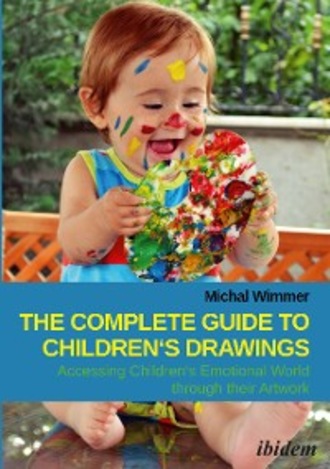
Полная версия
The Complete Guide to Children's Drawings: Accessing Children‘s Emotional World through their Artwork
In nature, there is a lizard which can change its head’s color to blue during sexual excitation periods. Toads see blue as water and a safe haven, hurrying to reach it in time of danger. Tamed chicks also associate blue with safety, so they tend to follow a blue figure.
In western civilization, especially in the US, brides traditionally wear a blue accessory as a sign of eternal love. On the other hand, blue is also associated with sadness and glumness, as in the blues musical genre.
Blue is also associated in the western world with the working class, as in the term “blue collar” worker. Some experts recommend wearing blue shirts to job interviews, because blue has a good and soothing effect on the interviewer. Blue affects our nervous system and causes a decrease in breathing rate and blood pressure.
Lüscher associated blue with tranquility and content, as well as a need to be physically or emotionally relaxed. Psychologically, blue represents the tendency to be sensitive and easily offended. According to Lüscher, blue symbolizes the relationships a person has with his surroundings and his sense of belonging.
Goethe differentiated between the various blue hues. On one end of the scale, it gives us a cold impression, and on the other reminds us of a pleasant shade. Kandinsky referred to blue as a color which creates a sense of loneliness, melancholy and daydreaming.
In children’s drawings blue represents relaxation and calm behavior patterns. Children who tend to use blue in their drawings will search quiet social interactions and will try to achieve harmony and pleasant atmosphere in their relationships with others. In their family relationships these children behave logically, demanding logical explanations and refusing to accept answers such as: “Because I said so...”. Children who tend to use blue are also characterized by a rich inner world, and it is important for them to express it.
Exaggerated use of blue represents cold, distant and restrained communication. It may also symbolize the child’s lack of confidence, oversensitivity, vulnerability and even his tendency to suppress his feelings.

Figure 2-7:Excessive use of blue
The following example was made by a 4½ year-old child whose parents contacted me because he had social and emotional difficulties. One of the issues that concerned them was that he didn’t have many friends at kindergarten because he was offended easily and when he met them in the afternoon, he insisted they meet only at his home. The excessive use of blue in his drawings represented his restrained communication pattern and social difficulties, as well as his low self-confidence and vulnerability.
You should note, however, the amount of blue used in the child’s drawing as well as graphic indicators in it. The parents of the child who made the next drawing contacted me because his kindergarten teacher reported that he was having a hard time, which made him nervous and caused him to beat other children.
The boy’s decision to use blue in this drawing is very clear, as it is spread over the entire page. In addition, he draws in an angular line, rapid movement and various pressure levels.
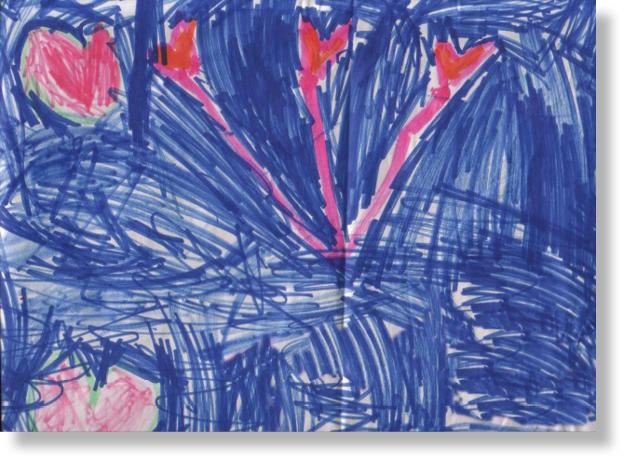
Figure 2-8:Extreme use of blue, combined with rigid, fast line movement and variable pressure level
Integrating all these factors indicates that this child has some emotional difficulty, which he tries to overcome by using the cold and relaxing blue. In other words, blue was used in this case to compensate for fears and anxieties that the child has but are unspoken, yet causing his unpleasantly distancing behavior, which is expressed either actively (aggression), or passively (withdrawal or detachment).
Purple
Queen Cleopatra of ancient Egypt loved purple. She loved it so much she forced her servants to immerse 20,000 snails for 10 days, so that they would secrete enough purple mucus. In Christianity, the pope and cardinals wear purple – perhaps the most expensive dye in the pre-modern world.
In human color psychology, purple is considered symbolic of royalty, nobility and gift. In one of his letters, Leonardo da Vinci wrote that he found meditation to be ten times more powerful when performed in a purple-colored room or under purple light. Similarly, Wagner used to compose his operas in a purple room which he called “my inspiration room”.
Lüscher described studies that associate purple with emotional and mental immaturity. In his opinion, preferring purple represents emotional fears, which cause people to create an imaginary world, while ignoring their surroundings. Such perception of the world as an imaginary place matches children’s natural view. In other words, purple is associated with escapism, usually caused by hidden anger or sadness. Another meaning purple has in our culture is the wish to charm others. Kandinsky noted that purple is created when red withdraws into blue. Therefore, purple is more related to blue in its meaning and associates with sadness and distance.
In children’s drawings purple is symbolic of imagination and intuitions. These children demand others to be particularly patient with them and are sensitive about managing things in their own pace. They have principles and ideas from an early age and it is important for them to keep them. In addition, children who tend to use purple may be characterized as daydreamers and generally confused.
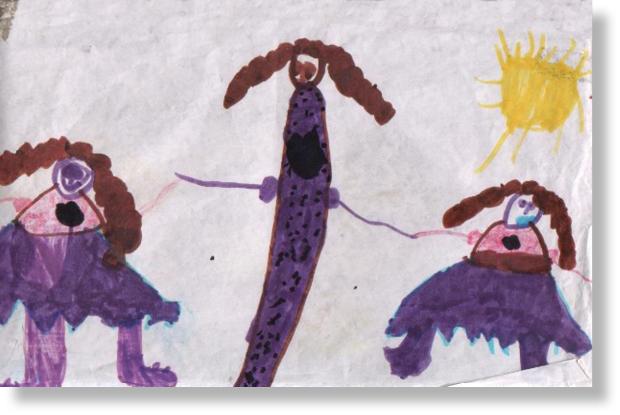
Figure 2-9:Excessive use of purple
This drawing is an example for exaggerated use of purple. The excessive use of purple symbolizes the girl’s connection to her childhood experience, in the simplest sense of what it means to be a child. Note that although this girl is very in touch with her intuition, this connectedness to her childish side clashes with daily demands by her parents who think she is not grounded enough in reality.
Green
Green often appears in children’s drawings as it is also common in nature. Children are aware of the green color of tree and plants, but do not always use it when drawing them.
Historically, green symbolized victory. Green bay leaves were laid on the victor’s head in ancient Greece. In ancient Egypt temple floors were painted green as a sign of success and victory. In addition, green was considered symbolic of resurrection and immortality. Nowadays, green is often used symbolically in many African countries to represent natural richness, but also in Islamic countries, because it is considered by Islam to be sacred, as it is symbolic of the lushness of paradise. Green is also associated with prosperity, as in the dollar bills.
Since green is a cold color, it is usually considered calming and harmonizing. For example, green is used in billiard or card games tables, because it creates harmony between the gamblers. In medicine, green is often used in surgery rooms or clinics, to create a relaxing atmosphere.
Culturally, we associate green with envy, as well as with beginnings (“green light”). Politically, green represents environmental activism.
According to Lüscher, green is symbolic of willpower, diligence, stability, self-awareness and self-esteem. Green is characterized by precise, factual and critical assessment. It is also associated with efficiency. In addition, Lüscher sees in green a symbol of one’s will to outstand, impress, dominate and receive recognition from others, in order to boost one’s self-confidence. Kandinsky and Goethe both share the opinion that green projects peacefulness, stability and quietness.
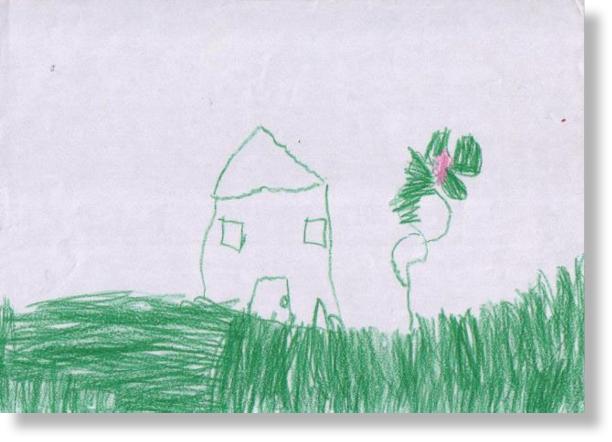
Figure 2-10:Excessive use of green
In children’s drawings green symbolizes many characteristics of childhood such as fresh start, different and unique view of situations, learning and a need for space. Consequently, green appears more often in drawings of children who like nature and outdoor games.
This drawing was made by a 5 year-old. No need to refer to the grass or stalk which are naturally green. However, it is clear that the child chose not to use any other colors, so that the house is made of green contour lines, as well as green windows and door.
Recall that we must examine a large number of drawings in order to draw conclusions about the child’s personality. In this case, as in other drawings by the same child, green is used extensively. Excessive use of this color may indicate compensation, for example, for the child’s need to learn, start anew and blossom.
In the case of this particular child, excessive use of green indicates his fears of learning. At the time of this drawing, the child started first grade and was afraid of studying and found it difficult to manage in class, mainly due to motoric difficulties not diagnosed before my analysis of his drawings. This child used to sit next to his classmates in front of the teacher and blackboard but could not compare himself to their capabilities, mainly because he could not copy quickly enough from the board. As already noted, the combination of excessive coloring with graphic indicators, such as the shaky lines representing the house walls and roof, lends further support to my conclusion regarding his emotional difficulty.
Gray
In nature gray is associated with fall and wintery weather. In many languages, a “gray” face is a weary facial expression. Gray life is a meaningless and boring life, and a gray job is similarly boring and lacking in glory. Nevertheless, somewhat ironically, shades of gray represent a balance point of view, as opposed to the sharp dichotomy of black and white.
The brain tissue is called “gray matter”, associating the color with thinking. The term “gray market” refers to semi-legal economic activity. Finally, a “gray area” represents territories or activities known to be problematic but that is not dealt with specifically by the law or enforcement authorities.
Lüscher associates gray with neutrality, a wish to “sit on the fence”, but also a border. This is why we often observe gray boundaries in drawings, which protect the painter from external threats.
In children’s drawings, gray is usually used topically, as in gray clouds. In addition, gray, just as any other color, has a range of qualities – positive and negative. Children tend to use gray mainly in its negative aspects. However, gray may also indicate positive aspects such as the ability to integrate or perform measured steps. Remember that the color analysis must be supported by other indicators, primarily graphic indicators and that it is this combined analysis that will determine the meaning of the color.
Brown
Brown is the most dominant color in nature besides green. It appears in landscapes, plants, animals, as well as in the color of our eyes, skin and hair.
Lüscher refers to brown as a symbol of sensation. Meaning, brown is the reflection of our physical aspect. In addition, it was found that when a person feels uncomfortable with his family, or experience physical insecurity or discomfort, he will tend to choose brown. That is, the choice of brown indicates an increased need for physical and sensory comfort. This could indicate lack of confidence or actual physical illness. The lack of confidence could stem from conflicts or problems the person feels unable to cope with.
In most cases, brown will be used realistically in children’s drawings. For example, the earth will often be painted in brown. Exaggerated use of brown indicates difficulty to deal with changes and tendency to prefer the well-known and familiar.
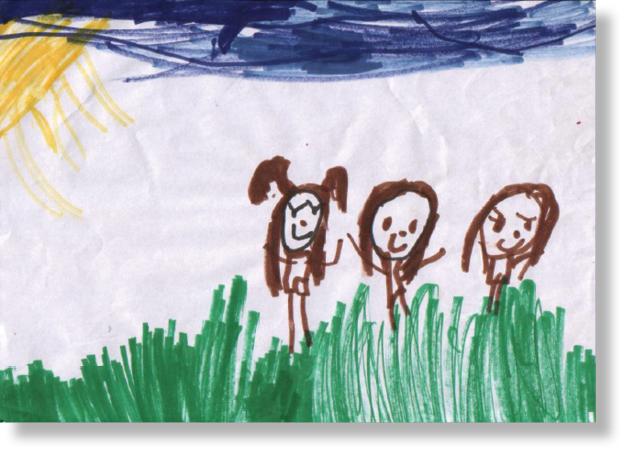
Figure 2-11:Excessive use of brown
The following example represents excessive use of brown. The child draws all figures completely brown, without any distinctions among body organs: eyes, eyelashes, noses, mouths, arms and torsos are all brown. Usually, in drawings by children her age, human figures are more colorful and their organs more distinct.
All shades of brown are characteristic of the human skin. Therefore, it may be that this girl attempted to find a color similar to natural body colors. However, other drawings by the same girls are also characterized by excessive use of brown. This means the girl may have needs associated with using that color, such as groundedness, stability, earthliness and confidence. She needs to know what is going on around her, down to the smallest details, to feel that confidence, otherwise she may suffer anxiety.
Black
One of the most commonly asked questions about children’s drawings is about the meaning of black. In western culture black symbolizes mourning, bereavement or depression. However, in other countries and cultures white is used to represent these situations and sentiments. In western society, if a person had a rough day, he would say that he had a black day. Black is also associated with dark and mysterious events – for example, a black cat as a sign of the evil eye, black lists, black humor and black magic.
However, black is also associated in our culture with authority and momentousness, as in “black tie” events. In Japanese culture, black is a symbol of nobility, age, and experience.
According to Lüscher, black negates any other color and as such symbolizes relinquishment, surrender and abandonment. But black also has an ability to emphasize and empower any color drawn next to it. Kandinsky associated black with eternal silence, without hope.
When analyzing drawings, recall that the use of black is not culturally dependent. In that it is similar to many other elements in children’s drawings, such as houses, which appear in the majority of children’s drawings from diverse cultures in the shape of a triangle placed on top of a square, regardless of the real-life appearance of their lodgings.
Likewise, the use of colors in drawings is not culture-dependent, and when a child draws exclusively in black, it definitely does not mean he is depressed or in mourning. Thus, you can find black drawings even in countries where mourning is represented by other colors, such as red in South Africa, blue in Iran, and the white flags hoisted along the streets of Colombo, Sri Lanka, following the Tsunami disaster.

Figure 2-12:Excessive use of black
Most children use black in their drawings simply because it gives a strong and dramatic effect to the drawing. Figure 2-12 was made by a 3 years and 5 months-old boy, who named it “The world in black”. By doing so, he increased his parent’s anxieties about his general condition. When I checked other drawings he made, it was found, in addition to other graphic indicators, that black was used sporadically, enabling me to calm his parents.
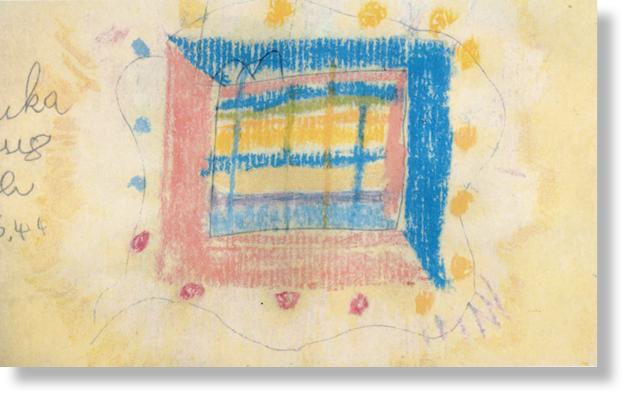
Figure 2-13:Black-less drawing from the ghetto
On the other hand, the next colorful and joyful-looking drawing was made by a girl who lived in a ghetto during the Holocaust, under severe stress and anxiety, before she was killed in an extermination camp.
There are some issues related to black that you must check. First, find out whether the colors in front of your child included only black, or did not include it at all. This may sound weird, but sometimes children simply draw with the colors in their possession. I once met a kindergarten teacher who consistently withheld black crayons from her children, explaining that she didn’t want the children to spoil their drawings by covering them in black. Such behavior could be the source of children’s strong attraction to drawing with black at home.
I do not recommend this approach, because colors are rich with personal meanings for children and it is important that they experience drawing freely and intuitively.
The next issue that you should check is the surrounding in which the drawing was made. Does the child draw differently at home, compared to kindergarten? Do drawings made while staying with grandparents include different colors than usual? Does the phenomenon repeat itself or appear in one drawing only?
If the child continues to draw exclusively in black, I advise checking his behavior when other colors are placed in front of him. Does he ignore them, or does he try them out but prefers using black? It is also important to note the length of time in which he chooses to use black exclusively, similarly to the “pink period” or “heart-shape period” common among girls, which passes naturally with age.
Many children who prefer black argue that it is “the most powerful color”, since it can erase all colors painted underneath. In addition, it forms a strong contrast with the page’s white color. Nevertheless, if the child persists in using black excessively, you must check whether he suffers from some visual problem, perhaps color blindness (if the child’s age allows you to make such a diagnosis). Interestingly, a study conducted among children with learning disabilities, perceptual and visual problems found that drawing on black paper made it easier for them to create a wider variety of shapes and details, probably thanks to the strong contrast provided by black (Uhlin 1979).
In any case, even if the use of black is exaggerated, you must refer to the overall drawing level: Does the child draw in an age-appropriate manner? Does he enjoy drawing? How much pressure does he apply while drawing? If the pressure is very intense, to the point of punching holes in the paper, the use of black may indicate emotional inhibition, internalized fears and fear of criticism.
To conclude, the colors in children’s drawing paint a fascinating picture. Nevertheless, it is important to beware of attributing far-reaching meanings and spiritual symbolism to little children. The combination of meanings of the colors in children’s drawings, combined with the meanings of graphic parameters and the various symbols in other elements, can add a deeper layer of significance to our interpretation of colors and shed light onto the drawing child’s subjective emotional world.
The Meaning of Colors in Children’s Drawings
Red – A dominant and extroverted child who likes to be at the center of attention. He is active and full of enthusiasm. Like challenges and competitions and strongly needs to be the winner. Usually, his behavior is goal-directed – he can get what he wants and does not easily let other children have their way.
Orange – An energetic, enthusiastic boy who loves doing. Usually, very creative and brimming with optimism. Willing to dare and join new experiences, and showing charming mischievousness. Obeying the rules does not come easy to him and he demands clear explanations for every request.
Yellow – A clever boy, highly sensitive to his environment. He is playful and full of joy of life, but not a “troublemaker” like his red friend. He is strongly connected to his family and does not need “the boys” to find interest. Has a rich inner world and good concentration.
Pink – Usually girls who love to be at the center of attention. They feel older than their age and require the environment to treat them accordingly. They are intensely interested in and curious about their femininity and end to give orders and act like “little mothers”.
Blue – An easygoing, calm boy. In his social conduct, he will seek quiet and harmony. He demands logical explanations and refuses to receive answers such as, “Because I said so!” Has a rich and intricate inner world, but it’s important for him to express himself and his wishes.
Purple – A boy with well-developed imagination and intuitions. Demands to be treated with exceptional tolerance, but conducts himself at a personal pace that suits him. He has principles and ideals that guide him and lead his thought and action.
Green – Curious with a passion for learning. He likes new beginnings and transition, and can examine situations in his life in a different and refreshing light. The educational approach to him needs to be liberal, with plenty of free space for action.
Brown – A judicious boy, who usually thinks rationally. As such, he demands and needs logical explanations. In his social conduct, he shows confidence and even leadership skills.
Black – A responsible boy with a presence, needs attention, prefers to be the social leader and decide for everyone.
3 Family Relationships
The parent-child relationship can be a challenging and empowering experience, but also a complex and exhausting one. Some may say parenting is one of the most complex and meaningful tasks in our lifetime and as such, it is rife with changes and internal conflicts. Drawings shed light on parent-child dynamics, helping us understand the reasons behind a child’s behavior and find unique ways to improve the atmosphere and relationship at home.
Family Coalitions
One of the keys to analyzing family drawings is identifying the common denominator to all family members. In children’s drawings this could mean similar colors, drawing style, clothing, accessories and so on. Children draw family members close to each other, even if they are distant in reality. By identifying the common denominator in a family, you will also be able to reach conclusions regarding inner family coalitions that are significant to the entire family dynamic.
Internal family coalitions refer to both overt and covert coalitions between parents and children that form the family power structure. For example, if children, during an argument, often tend to agree with the mother, it will be very hard for the father to stand up to all of them.
Nevertheless, it is important to note that the way a child draws his family does not necessarily reflect the reality he lives in. Children often beautify their lived reality or draw more desirable family power balances. Be that as it may, drawings will enable you to understand how family relationships are perceived by a child and reach conclusions regarding his general behavior.
Most approaches to analyzing family drawings rely on Salvador Minuchin’s structural family therapy (1974). Structural family therapy basically assumes that the family is a structure in which a person’s identity is shaped.
According to this theory, the family is a living and developing organism. Similarly, the inner dynamics of family drawings also change as the family evolves. Eventually, the goal of drawing analysis is to find family-relevant solutions rather or in addition to particular solutions tailored to each member.
In spontaneous drawings, based on the ambiguous instruction “draw a family”, you can clearly see whether a child is aware of his family boundaries. Drawings reveal how a child perceives the subsystems in his family. In other words, drawings will show his attitude towards parents and siblings. Some of the most common ways children use to describe relationships in a family are distance between figures, height and width of family figures, different colors and clothing.

Figure 3-1:Family coalition
At first glance, the drawing in figure 3-1 does not seem to indicate the existence of any internal family coalition, mainly because all family members are drawn in the same color and all seem to be of the same height. However, the topographical location of the figures on the page (the form of the ground line beneath their legs) indicates the existence of a coalition nevertheless, with the eldest boy standing on the same plain together with his parents, while the 5½ year-old girl who made this drawing and her little brother forced onto a different plain, with added “grass” to compensate for their stature and make them as “tall” as the eldest brother and the parents. In this case, height of course represents dominance in the family system.



